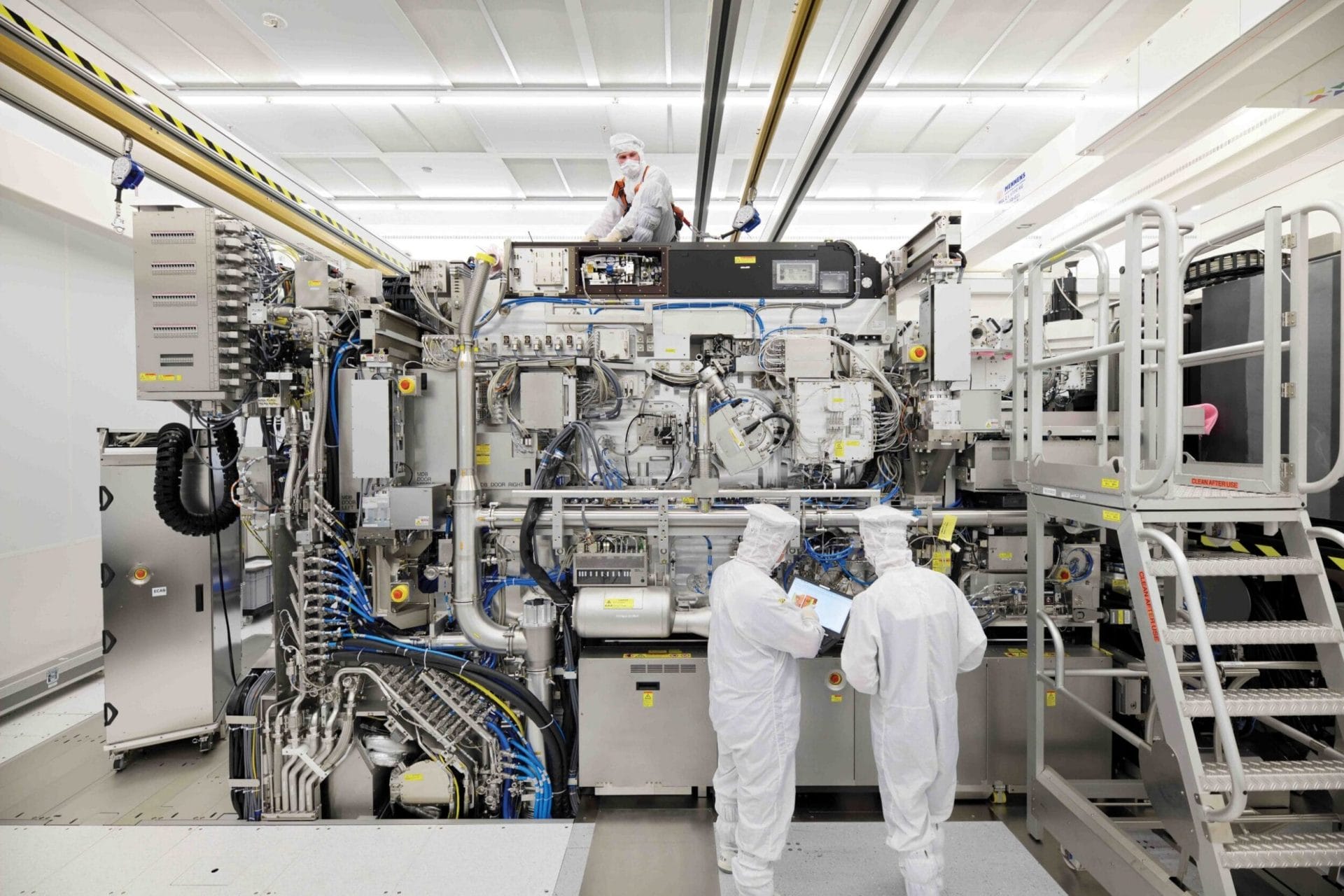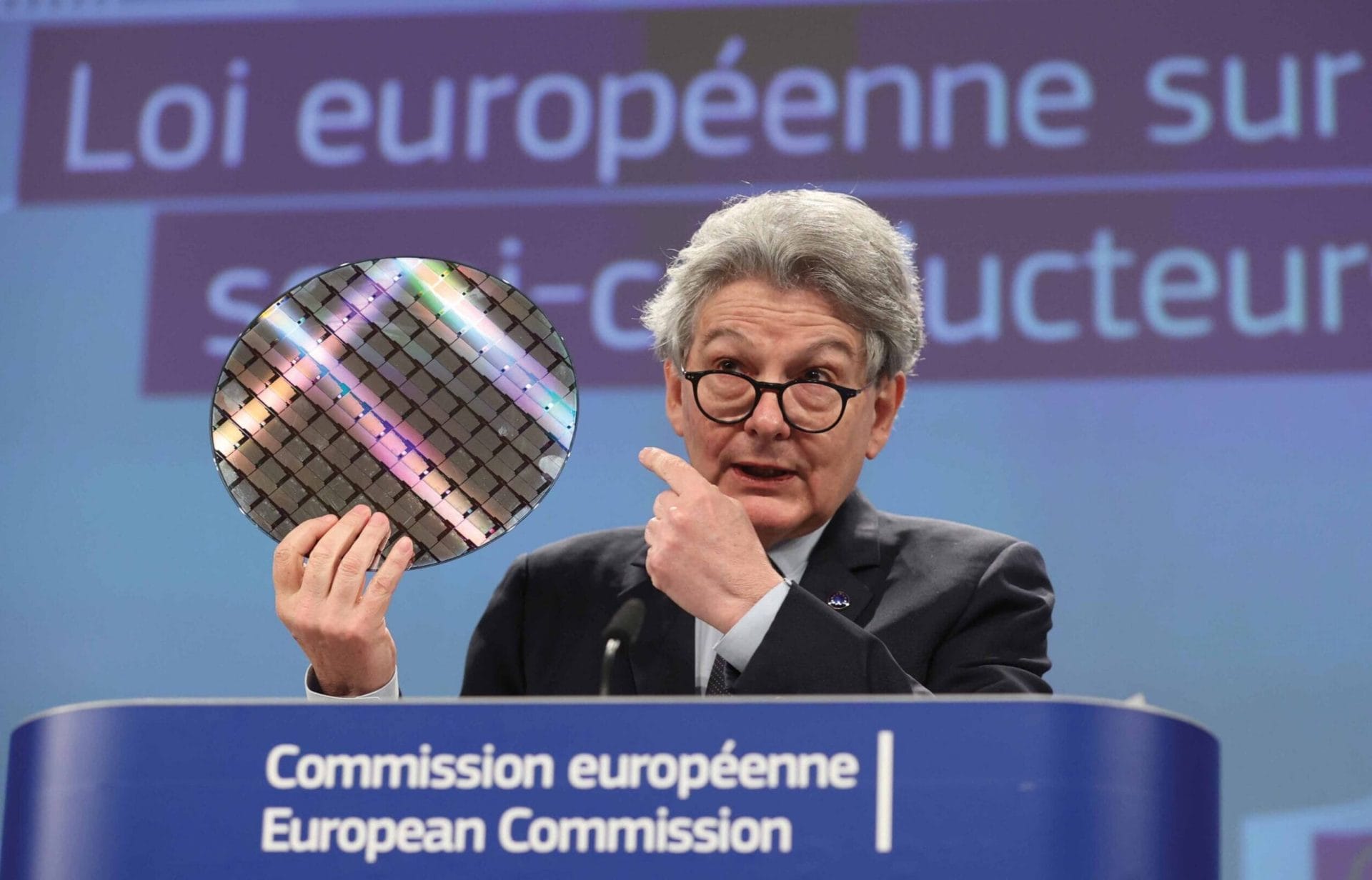The gods of small things
American efforts to maintain a lead on silicon chips are pushing the US into an escalating standoff with China. These tiny bits of technology are at the frontline of a geopolitical struggle for power, wealth and security – but what are the flashpoints and future battlefields of the new chip war?

An engineer holds up a microchip in a semiconductor foundry. Nations which control the most cutting-edge chips will enjoy potentially huge commercial and military advantages. Photo: Sinology/Getty Images
7th October 2022 (Taken from: #49)
“The real problem of humanity is the following: We have palaeolithic emotions, medieval institutions and godlike technology” — Edward O Wilson, biologist
The Biden administration’s announcement was greeted – as its announcements often are – with spluttering outrage by China. An op-ed piece in the Global Times, an English-language tabloid mouthpiece for the Communist government, described the new measures published on 7th October as a “savage attack on free trade”, claiming that “Washington has lost its mind and way” and that the “very dangerous” US is “turning back the wheel of history.”
This purported backwards historical wheel-turning was over US policy on semiconductors, aka microchips, those scraps of silicon that control everything from your kettle to the three exploration rovers (two American, one Chinese) currently beetling their way across the surface of Mars. The directives, introduced by US under-secretary of commerce Alan Estevez, were draconian. They banned the export to China of advanced microchips built with US-made equipment, prevented the sale of US chip-design software and chip-making equipment to China, and forbade US citizens from working in Chinese chip-making firms.
Beijing saw the move as a US bid to maintain its advantage in semiconductor technology by stymieing Chinese development. “Out of the need to maintain its sci-tech hegemony, the US abuses export control measures to maliciously block and suppress Chinese companies,” complained Chinese foreign ministry spokeswoman Mao Ning in an official statement.
“That’s a fair assessment,” says Madeline Carr, professor of global politics and cyber security at University College London, referring to Ning’s anguished pronouncement. “But this hasn’t come out of the blue. There’s always a tension between protecting one’s own indigenous industry and the principles of the open free market.” The difference in this case, says Carr, is that the protectionism is happening in the tech industry, which the US has “kind of owned for the last 50 years,” particularly when it comes to chip design. “We’ve got to the point where [the US is saying] we need to slow down innovation and technology in China, to put material constraints in place. The shocking bit is that the US feels that vulnerable.”
There’s certainly a lot at stake. The global semiconductor industry is worth $600 billion and counting, and the AI and supercomputer-based technologies set to shape the future of the global economy – autonomous transport, personalised medicine, the Internet of Things – depend on it.
Perhaps even more significantly, however, the most advanced microchips are also key to the creation of new defence technology, a fact explicitly recognised by Estevez. “My north star… is to ensure that we are appropriately doing everything in our power to protect our national security and prevent sensitive technologies with military applications from being acquired by the People’s Republic of China’s military, intelligence and security services,” he said in his introductory notes on the new measures. The efficacy of AI-driven drone swarms, hypersonic missiles and ‘slaughterbots’ on the battlefields of the future will depend not on the skill of generals but on the speed of semiconductors. Faster and more sophisticated chips will give potentially decisive advantages in wars fought by autonomous killing machines guided only by bloodthirsty algorithms.
October’s announcement by the US triggered big drops in the price of Chinese tech companies, with some like Shanghai Fudan losing as much as 20 percent of their value overnight. But western companies suffered too – including the Netherlands-based ASML (Advanced Semiconductor Materials Lithography), creator of the most advanced microchip-making technology in the world, a fact which puts it squarely on the front line of the new chip war. It briefly lost 16 percent of its market capitalisation as investors digested the abrupt latest step in the dismantling of global supply chains.
ASML, currently valued at €250 billion, started life in a leaky shed in Eindhoven on April Fool’s Day 1984. It was here that 31 engineers from electronics giant Philips set out to create a lithography machine for printing microchips. The principle behind the technology is simple: you place a pattern of your intended circuit onto a platform known as a reticule and then focus light through it onto a wafer of silicon coated in light-sensitive chemicals, thereby printing your design. The circuit is composed of individual transistors – switches which encode a single piece of data by being either on or off, set at ‘1’ or ‘0’.
Having created their first commercial machine, the PAS 2000 stepper, the engineers of ASML rapidly graduated from their lean-to and spent the next 30 years perfecting their technology. In that period, following the ‘law’ identified by Intel co-founder Gordon E Moore back in 1965, the number of transistors on a chip roughly doubled every couple of years. At the time of the Apollo 11 mission, microchips held around a thousand transistors; today, Apple’s M1 Ultra chip, snugly ensconced in many a tablet near you right now, holds 114 billion transistors in the same space.
To cram so many transistors onto a microchip, manufacturers etch at the level of nanometres [billionths of a metre], deploying methods that operate at the outer edges of physics. ASML’s EUV – Extreme Ultraviolet Light – technology, over which it has a total worldwide monopoly, is proudly on display at its gleaming experience centre in the otherwise unexceptional Dutch town of Veldhoven. Here visitors can see mementoes from the early days of ASML and don headsets to watch explanations of precision lithography. It is mind-bending stuff.
Generating EUV light takes a very strong laser fired at droplets of tin… turning them into a plasma at 400,000 degrees Celsius”
Extreme ultraviolet light only occurs naturally in space – in the coronas around stars – so it has to be artificially created on Earth. “Generating EUV light takes a very strong laser,” says ASML spokesman Sander Hofman. “We use an industrial high-powered laser of 30 kilowatts, one of the strongest in the world. It can cut through steel like butter. This laser is fired at droplets of tin that are ejected out of a generator at a speed of 50,000 per second. The laser hits each and every one of these droplets, not once but twice. The first time is with a low intensity beam, which turns them into this sort of pancake shape. Then you hit them at high intensity, turning them into a plasma at 400,000 degrees Celsius that emits light of all kinds, among which is the 13.5 nanometre EUV wavelength.”

One of ASML’s extreme ultraviolet light (EUV) lithography machines. Photo: ASML
This light then needs to be precisely focused onto the silicon: to do this it is bounced between a series of mirrors so flat that if they were scaled up to be the size of Germany, the biggest bump on their surface would be only a tenth of a millimetre high.
As EUV light is absorbed by air, this whole process takes place in a vacuum, and as contamination of the reticule by the tiniest speck of dust would ruin the print, the machines, once delivered to customers by ASML, have to be housed in ‘clean rooms’ whose atmosphere is kept ten thousand times purer than the air outside. Given that the slightest jiggle during printing could be equally disastrous – and that many of these machines will end up used in earthquake zones – sophisticated balancing mechanisms counteract any tiny tremor to keep the light and reticule perfectly aligned. This technology allows the printing of transistors at a size significantly smaller than a coronavirus particle (or, for a more old school comparison, 11,000 times thinner than a page of Delayed Gratification).
The EUV system itself, says Hofman, “is about the size of a city bus. Then there’s all kinds of electronics cabinets and power supplies. It takes about three fully loaded cargo planes of material to deliver.” None of this comes cheap. An ASML EUV machine costs around $200 million, and setting up a series of them in a microchip foundry – also known as a ‘fab’ – costs around $20 billion.
Once you’ve hired your highly trained, highly paid staff and installed your equipment, the pressure is on to produce as many chips as possible before the whole setup is rendered out-of-date by the onward march of Moore’s Law. In the noughties there were scores of cutting-edge chip fabs, but now there are only three companies prepared to pay such elevated prices and work at such intense rates: Intel in the US, Samsung in South Korea and TSMC – the Taiwan Semiconductor Manufacturing Company.
Stopping China getting its hands on TSMC adds an extra incentive to defending Taiwan”
TSMC started not with a leaky shed but with a blank cheque. Taiwan had been bringing in foreign chip companies – attracted by a cheap workforce and tax breaks – since the 1960s. Then in 1987, determined to develop a homegrown industry that would provide high skilled jobs for its citizens, the government facilitated the launch of TSMC, providing almost half of the startup capital and supporting it as it went on to produce billions of semiconductors each year, many made with ASML machines. It now has a turnover of £62 billion, 65,000 employees and produces 90 percent of the world’s most advanced microchips.
This production dominance, as Carr points out, is a problem. “If this concentration were almost anywhere but Taiwan it might be okay, but to have it at the nexus of this strategic competition between China and the US is just deeply unfortunate,” she says – although she plays down the prospect of war breaking out over Taiwan, despite growing confrontation between the two sides. “Neither the United States or China wants to go into conflict over Taiwan, that’s for sure.”
Whether or not China is seriously contemplating an armed invasion of Taiwan by the People’s Liberation Army (PLA), Chinese sabre-rattling has certainly increased in recent years, with incursions of Chinese warplanes into Taiwanese airspace rising from 380 in 2020 to 1,727 in 2022 according to Taipei. The US policy of ‘strategic ambiguity’ has been undermined by President Biden, who explicitly stated as recently as September 2022 that US troops would fight to defend Taiwan against takeover by China. While there are many noble reasons to protect a fellow democracy against unwanted takeover, stopping China from getting its hands on TSMC – and leapfrogging past the US’s technological lead – adds an extra incentive to the rationale for defending Taiwan, a phenomenon known in diplomatic circles as the ‘silicon shield’.
The Covid-19 pandemic gave the world a small preview of the shock that would occur if natural disasters or the onset of war stop advanced chips from flowing to the west from TSMC’s foundries. In 2020, with up to a third of humankind confined to quarters in the rolling lockdowns that overtook the globe, the auto industry entered a dark place and cancelled its orders for billions of chips used in its cars, which contain as many as 1,400 separate semiconductors each.
The spare production capacity was swiftly snapped up by producers of games consoles, Pelotons, bread machines and sundry other lockdown diversions, and when the auto companies restarted production they found themselves at the back of the queue for chips. In the UK the waiting list for high-end four-wheel drive cars increased to more than a year. But it wasn’t just aspiring Chelsea tractor drivers that suffered. Covid outbreaks in global chip foundries and packing centres, the tortuous supply chain logistics caused by travel restrictions and bouts of international chip hoarding meant that whole industries seized up overnight.
The shortage got so bad that in April 2022, ASML’s CEO Peter Wennink told investors that he knew of a major industrial conglomerate that had begun buying up large numbers of new washing machines, purely to strip out their semiconductors for use in its own devices. The mental image of workers smashing up pristine white goods en masse just to harvest their precious chips has focused the minds of politicians across the world.
Another potent rocket up the bottoms of the global political class came in the form of Russia’s resource extortion after its invasion of Ukraine: in the same way that Putin limited gas flows to Europe, might China, having invaded Taiwan, impede the flow of semiconductors to nations that objected to its land grab? While Europe has replaced Russian hydrocarbons with liquefied natural gas from Qatar and the US, western nations would have no similar swift recourse when it comes to advanced microchips.
Whether the next chokepoint comes through a new zoonotic pandemic, an east Asian earthquake or the arrival of the PLA in Taipei, no government strategist wants to be left exposed when the chips are down.
This new awareness of silicon vulnerability has triggered frenzied spending on programmes to develop homegrown chip industries. “It became very apparent to governments around the world how strategic a commodity semiconductors are,” says Hofman. “You start looking and you see that the vast majority of chips are made in Asia, not in the US or Europe. Chip manufacturing is dependent on regions like Taiwan and Korea. Everything that you see happening today flows from that realisation.
In August 2022, President Biden signed the CHIPS act into law. As well as having reverse-engineered a plausible acronym (Creating Helpful Incentives to Produce Semiconductors), the government announced the channelling of $280 billion into upgrading the industry over the coming decade, including tax incentives for manufacturers and $200 billion for research and development.
It sits alongside recent CHIPS act equivalents in the EU (€43 billion), India ($10 billion) and Japan ($6.8 billion), also aimed at onshoring building capacity and unpicking reliance on global supply chains. TSMC has started hedging its bets in case of Chinese invasion, investing in new foundries in the US and Japan, and making plans for a new plant in Germany. Meanwhile China has been offering extraordinary perks – including reported 300 percent pay increases, subsidised accommodation and up to eight annual free trips home – to Taiwanese microchip engineers who are prepared to bring their expertise to the mainland.
The UK hasn’t followed the global pack with big new investments, and the country is still awaiting an overdue semiconductor strategy, which the government promised to deliver back in April 2022. A group of eminent tech industry heads wrote to prime minister Rishi Sunak in January 2023 lamenting the lack of direction, pointing out that chip shortages are helping to stoke inflation, that “confidence in the government’s ability to address this industry’s vital importance is steadily declining with each month of inaction” and that “given this nation is at the centre of tensions between China and the west, it is paramount that global dependence on Taiwan is addressed.”
Britain hasn’t entirely sat on its hands, however. It did gamely join in with an act of chip nationalism in November 2022, overturning the purchase of Newport Wafer Fab in Wales – the biggest foundry in the UK – by Chinese-owned company Nexperia, on the basis of a “risk to national security”. This move prompted a cri de coeur from Nexperia’s UK country manager, Toni Versluijs, who said the decision “sends a clear signal that the UK is closed for business… It is wrong for the UK economy – undermining its semiconductor industry as we brought new production to Newport. It is wrong for the UK taxpayer – who could now be faced with a bill of over £100 million for the fallout from this decision.”

Thierry Breton, European commissioner for the internal market, brandishes a silicon wafer on which microchips are etched, during a meeting on the chips act at the EU headquarters in Brussels, 8th February 2022. Photo: Dursun Aydemir/Anadolu Agency via Getty Images
The UK’s failure to leap into action may, inadvertently, have been a shrewd move. The talk in the industry is now of current shortages of the more standard chips, produced with less sophisticated machines, turning into future gluts as the new subsidised fabs in the US and EU come online and demand is dampened by inflation, sluggish economies and consumers shamefacedly selling on their Pelotons, untouched after an initial flurry of enthusiasm and a brief spell as an improvised clothes rack.
Future technologies could dramatically influence the outcome of the chip war, with glittering prizes on offer for their inventors.
First on the agenda is further transistor shrinkage. “If you look at the chipmaker roadmaps you will see that there is a solid plan in place for well into the next decade,” says Hofman. “Some chip makers like Intel will start to drop nanometers and move into the next denominator –the angstrom [one ten-billionth of a metre]. And then there are new materials being investigated that will complement silicon, and make for better transistors and better chips. There’s this incredible creative push in the industry.”
Another area of innovation is switching away from traditional chips based on electrons flowing through circuits. These suffer from a key issue: the electrons vibrate as they go, producing heat and meaning that active chips need to be cooled down. This is why your computer is equipped with a fan, and why the vast data centres that make up the cloud now consume as much as one percent of global electricity production, much of it spent powering air conditioning to keep them from melting.
One possible alternative is to use photon light particles instead of electrons as the information carrier in chips, in the same way as fibre optic cables replaced copper cables in communication networks. There are huge technical challenges in making photonic chips an everyday reality, but their impact would be enormous – photons have no mass and travel at the speed of light, meaning chips that used them would be far faster and way more energy efficient.
And then there’s quantum computing. This replaces the bits of data encapsulated in silicon chip transistors with ‘qubits’ (quantum bits), which make use of the ‘superposition’ effect of quantum mechanics. This effect means that subatomic particles can represent the states of ‘0’, ‘1’ or both at the same time, instead of the limited binary choice of traditional bits. Making use of electrons, photons or other particles in this way could lead to a potentially exponential increase in processing power.
The players that develop emerging technologies will then set the standards and the rules”
All of this cunning subatomic witchcraft, however, works best in quantum computers at -273.13 degrees Celsius, just 0.02 degrees above absolute zero, the lowest temperature thought possible in the universe. On 30th January 2023, Chinese state media announced that the 24-qubit Wuyuan, notionally the country’s first practical quantum computer (although realistically still not much more than an experimental device) had already been delivered to a customer.
Meanwhile, ASML has spent billions of euros over the last few years working on its latest EUV breakthrough. Its ‘High Numerical Aperture’ machine will, it says, enable printing at the 10 nanometre level and below. Its first shipment of the new tech, expected to be sent out as early as 2025, will reportedly be going to Intel. Securing the new capability before anyone else is a coup for the US tech giant which in 2021 announced a new partnership with DARPA, the research arm of the Pentagon, to produce microchips for advanced defence systems.
On 17th January 2023 President Biden met with Mark Rutte, lobbying the mild-mannered Dutch prime minister to join the US in blocking the sale of advanced microchip manufacturing equipment to China, with the aim of cutting its rival off from ASML’s innovations. Chinese leader Xi Jinping also leaned on the beleaguered Rutte at a recent meeting, making it clear how displeased China would be at any such move.
“I feel sorry for Rutte in a way,” says Carr. “That’s a high pressure situation to be in. But in another way, it’s an incredibly powerful position, for a small player. Imagine that you had two huge organisations wanting to hire you, aggressively bidding for you. It could give you a tense weekend, but could also work very well in your favour if you had the negotiation skills and the wherewithal to deal with a situation like that.”
On 28th January 2023, it was reported that the US had succeeded in persuading both the Netherlands and Japan to block all sales of chipmaking equipment to China – which means China will not just be stopped from buying EUV machines from ASML, but also the previous generation of DUV (deep ultraviolet) machines from Nikon in Japan. Both the Netherlands and Japan are treading a careful diplomatic line at the moment, and confirmation of the agreement may not come for a while. But if it is true, it’s a resounding slap in the face for China, a nation not known for its stoic acceptance of international insults.
Whether this diplomatic wrangling will pay off in the longer term is unclear. The US may succeed in holding back China’s semiconductor industry and keeping it from deploying the next wave of commercial and military technology. It may, however, just incentivise the People’s Republic to innovate – or invade – its way around the problem, investing in its own godlike technology or sending an armada to Taiwan in a blaze of atavistic fury.
Carr says that China’s motivation to succeed is strong. “They’re very determined, this is what their future is plotted out on, and the players that develop emerging technologies will then set the standards and the rules,” she tells me. “The most sensible thing for the US to do, wherever possible, is to throw some marbles in front of their bicycle and hope that they wobble.”
First blood in the high stakes skirmish launched in October appears to have gone to Washington. The chip war, however, continues.
Slow Journalism in your inbox, plus infographics, offers and more: sign up for the free DG newsletter. Sign me up
Thanks for signing up.








